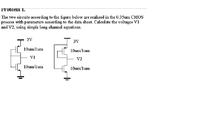santom
Full Member level 2
Hi all
I was trying to solve some of the old exam papers for my exam.I am not able to do the following problem.
Can anyone over here help me out in solving this problem with respective explanation.
(Also, please note that questions like this will be posted by me especially this week .So any good friends who are willing to help me out in solving are most welcome.I surely will be very grateful to you as this exam is the most important for me)

Thanks in Advance
Santom
I was trying to solve some of the old exam papers for my exam.I am not able to do the following problem.
Can anyone over here help me out in solving this problem with respective explanation.
(Also, please note that questions like this will be posted by me especially this week .So any good friends who are willing to help me out in solving are most welcome.I surely will be very grateful to you as this exam is the most important for me)

Thanks in Advance
Santom